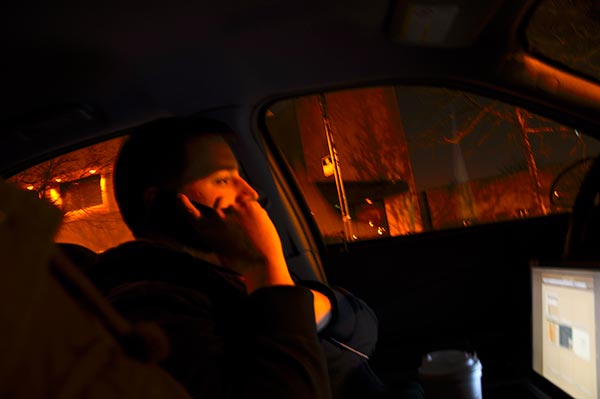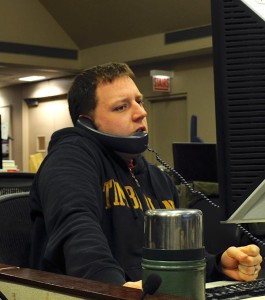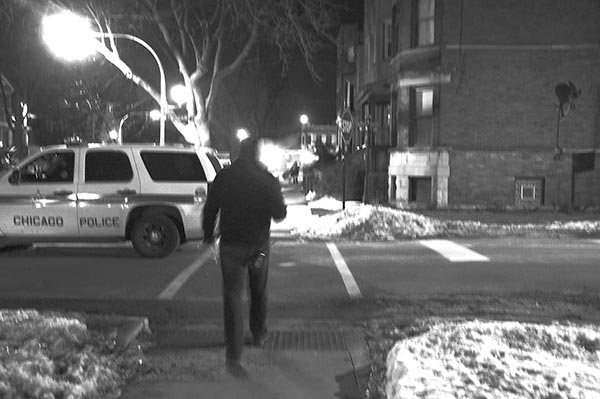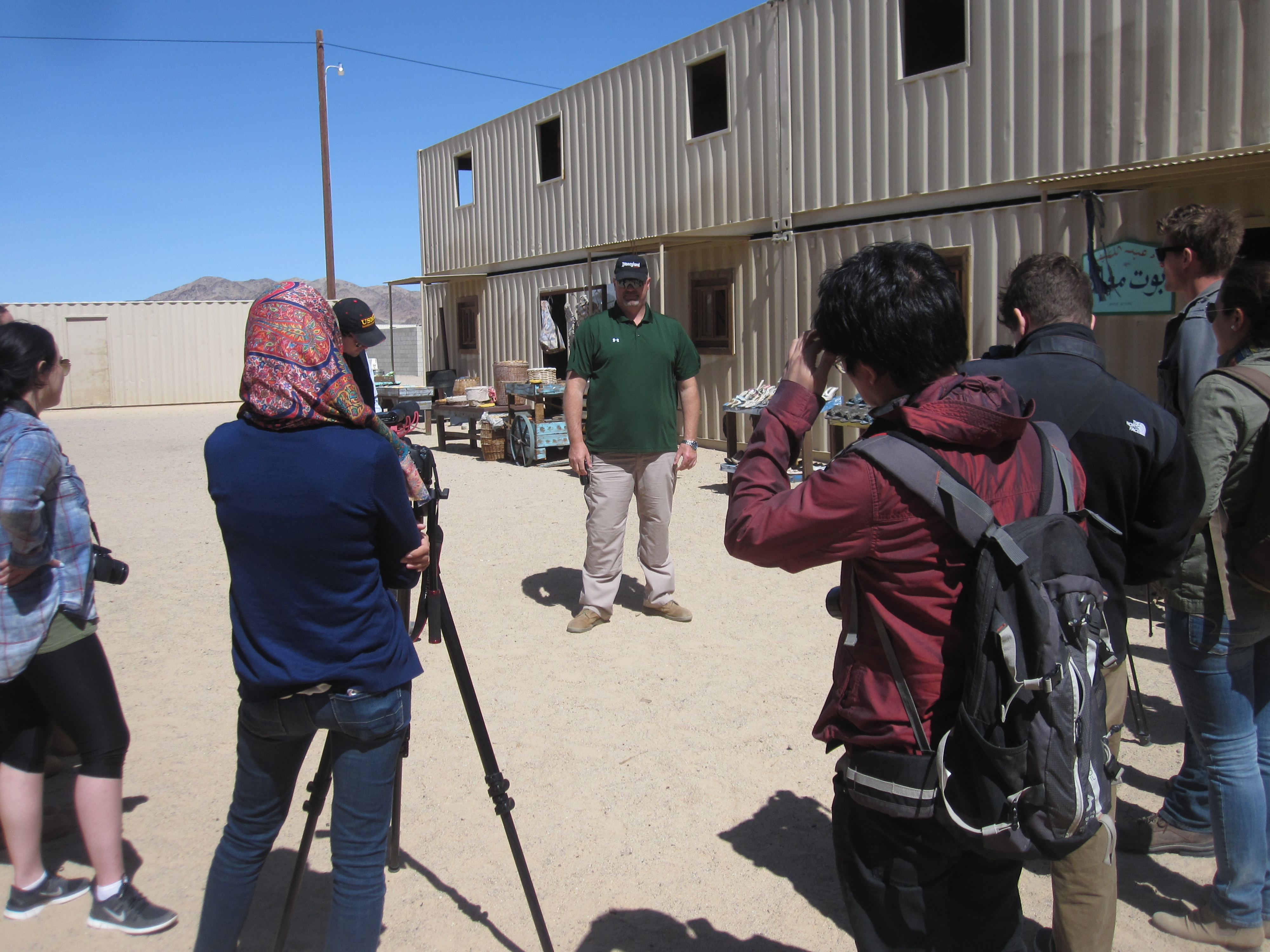
Peter Nickeas, 28, overnight breaking news reporter for the Chicago Tribune, makes a phone call from his office – his car. John Kuhn/MEDILL
More than 400 times last year, family members had to stand next to the lifeless body of a loved one. More than 400 funerals. More than 400 trips to select a casket. More than 400 mourned by family and loved ones.
More than 400 times, murder – mostly from violence concentrated in several already-fragile neighborhoods – visited the streets of Chicago.
Yet the headlines bragged about the historic lows: Only 431 in 2013, they noted. But that’s news outlets focusing on the stats. One reporter in Chicago has made a point of trying to understand the humanity – the humans – behind the stats, behind the headlines, by going where the murders happen, when they happen, just like the cops.
Peter Nickeas was one of the first to respond to more than 225 of those crime scenes. One of two overnight breaking news reporters for the Chicago Tribune, he stood next to people whose sons, daughters, mothers, fathers and best friends had just been killed, people for whom the historic lows of Chicago violence mean absolutely nothing.
Nickeas talks to police officers, gang members, victims of violence and their families and friends. But he doesn’t stop there, where most reporters do.
For example, a man shot George Anderson in the head while he was standing in the street near Marquette Park on June 7. Police tape surrounded his dead body. A drunken man stumbled toward the tape, his black T-shirt pulled up over his head. He tried to walk through the crime scene. Cops tried to pull him back.
Marchello Kellum watched all this unfold. While a police officer’s Taser threatened the drunken man’s bare chest, Kellum spoke:
“You’re being real disrespectful. That’s my brother-in-law there.”
None of this information made it into the paper. But Nickeas wrote down what he saw and heard, and he included it under the timeline section of the Tribune’s website, along with pictures.

Always on the phone, Nickeas stops at the Tribune a few times each night. John Kuhn/MEDILL
These short narratives reveal tension in crime scenes that typical stories with headlines like, “Man killed, four others wounded in Chicago overnight” lack. Nickeas writes both kinds of stories. But only one gets at what the 431 murders of 2013 mean for the city.
Nickeas is a part of an old tradition of crime reporting. The City News Bureau of Chicago used to serve as a wire service, alerting media outlets of breaking news. Reporters worked out of police stations and would sometimes go out with detectives.
But that started to dwindle in the ‘90s, and eventually the wire’s breaking news desk folded into the Tribune. And until Nickeas came along, overnight reporters worked from behind a desk, calling police districts for information. They went out only if there was a major story.
Nickeas is out every night. Two scanners, a laptop, phone, camera and sometimes even a staff photographer in tow, Nickeas’ car is his desk, the streets his newsroom. He encompasses both the beat-down fatigue of a worn war reporter and the compassion of a social worker. He talks straight, and in the language of the streets.
“My job is to take what I see and spit it out as something people can relate to. It’s about the neighborhood. It’s about the reaction. You can’t fucking do that unless you spend time on the job,” he said. “Nobody else, dude, is out there on the fucking streets.”
Dan Haar, Nickeas’ editor at the Tribune, said his timelines are resonating with people. The more traditional, bare facts stories, he said, have desensitized readers to the emotion hidden within them. And people want more.
“He gets email all the time from people saying, ‘You made me realize what this murder rate is really like,’” he said. “It’s something we should have been aching for. And now it’s indispensable,” Haar said.
Nickeas believes the city is tearing itself apart, and that covering the violence by dry numbers alone doesn’t help anyone understand the effects of the killings, which is why the streets are his office.
“I didn’t get into this so I could have a 9-5 punch the clock,” he said. “It’s important. I know it’s important.”
His timelines include what he sees and hears on the job. In one, “My soul is damn near destroyed,” he is at the funeral of 30-year-old Alphonso Love, killed just months after his 27-year-old sister. Nickeas is standing next to their mother:
“‘I don’t wanna go in there, I don’t wanna go in there,’ she cried again.
A man with white gloves held the glass doors open under a sign that read, ‘United Baptist Church’ and ‘Serving God through Humanity.’
The preacher’s steady voice guided Love and a small group of relatives down the aisle. ‘Yea, though I walk through the valley of the shadow of death, I will fear no evil: for thou art with me.’
The man with the white gloves shut the doors.”
In this way, “Pete shows you the numbers,” Haar said. “You see his eye. You see what he’s hearing. He’s watching and listening so he can show you the stories that he sees.”
You stand next to Nickeas and observe parents explaining to their kids the proper way to duck their heads when they hear that firecracker noise.
You see intoxicated and entitled nightclub patrons indignant that they are forced to walk around a dead person lying in the street.
You witness a man – stuck outside the tape surrounding the city’s latest murder victim – try to seduce a woman who’s unable to enter her home until the freshly killed body is removed.
Nickeas’ reporting demands that you think about having to explain to your 6-year-old why someone would want to hurt somebody else. In front of your house.
“How do you answer that question? Why should you ever have to answer that question?” Nickeas asked.
Haar said questions like this bring the numbers to life. “This shows you what a fatal shooting does to a neighborhood. What it did to 400 neighbors, 400 families.”
It’s why Nickeas believes the type of coverage he provides is crucial. He’s putting a face on national security issues that are often viewed in a macro sense. He’s portraying security as something intensely personal, which it is.
He said sweeping societal statements about bad people doing bad things don’t do the victims or the offenders of the violence justice. And the same goes with police department press releases.

Shuffling scanners, a laptop, camera and notebook, Nickeas reports and files stories from his car. John Kuhn/MEDILL
“You need to write about people making bad decisions,” and show that there’s a difference between excusing bad behavior and citing circumstances that contribute to it.
He said people should be aware of things like the Dan Ryan Expressway, which isolated poor, black Chicagoans from the rest of the community. To this day, the freeway—built while Richard J. Daley was mayor— contributes to the violence. But, “You can’t go around shooting people up because Old Man Daley was an asshole.”
These kinds of contributing factors aren’t present in all of Nickeas’ timelines. But the best ones get at them.
And it’s easy to forget just how hard—and sometimes dangerous—it is to do what Nickeas does during his shift.
Adam Sege is the other overnight breaking news reporter for the Chicago Tribune. He was hired a year after Nickeas, in October of 2012. Following the model set by Nickeas, Sege has produced similar work. Together and with the help of staff photographers, they bring the Tribune’s timelines to life.
He’s been chased by a man who he thought had a gun. Cursed at countless times by grieving and angry residents.
He has rules for his coined defense-by-offensive driving:
Don’t stop at red lights. Creep up to them, time them right. Don’t allow for ambiguity at stop signs. Make it clear whose turn it is to go. Avoid one-way streets that have speed bumps. Always avoid alleys.
His job takes him into dangerous places at dangerous times. Places where revenge is commonplace and the sounds of fired weapons echo only blocks away.
Personal risk is required of him in order to know the streets and neighborhoods where the killings happen. In order to describe them in timelines.
To cover the stories he does, to notice the detail and hear the conversations, “You have to keep your eyes open when you don’t want to. I’m good at keeping my eyes open,” Nickeas said.
Like when he and a photographer stuck around after firefighters left the scene of George Anderson’s murder and noticed Jennifer Wallace pour liquid from a yellow cup over the ground where he died, in silent tribute.
But what Nickeas sees comes at a price.
“When you’re standing back watching, you just have to absorb. It’s some sad-ass shit. If you’re around this drama it starts to affect you. It jades you. It affects your view on society,” he said.
But, “If it hurts me to write it,” he added, “I can basically assume that somebody’s going to read it.” Describing firefighters, for example, as they hose blood from a basketball court where 13 people were shot is probably tough to do. But it’s something most people don’t get to see otherwise.
It dredges up emotion. Exposes the broader hurt.
And that’s “like turning a light on and seeing things for what they are. Now you saw the people on the street. You saw people crying. You see how they remove the body. You see how they hose down the sidewalk. You’re seeing all this overnight. A lot of times it’s on a dark block—nobody cares that somebody’s dying,” Haar said.
It’s enough light to give a glimpse of those 431 families.

Nickeas responded to more than 225 crime scenes in 2013. John Kuhn/MEDILL



















